There’s no particular reason, two years after the fact, to be talking about Moonrise Kingdom. But there’s no particular reason not to talk about it either. [Why Jordan, one would almost suppose that you were dusting off an old post idea that you left hanging because you were supposed to be working on Cowboy Bebop. – Ed.] I’ll provide a little plot summary, though, since I’m sure we’ve all forgotten the fine details.
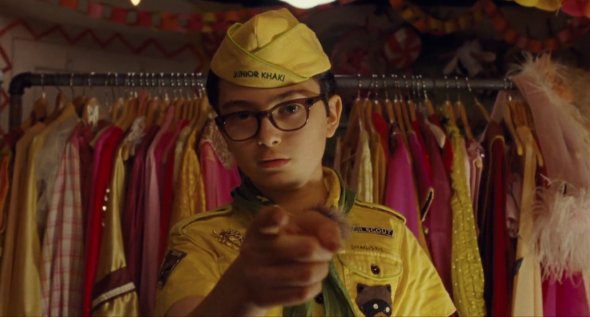
What kind of bird… are you?
Meet Sam. He’s an orphan, a serial foster child, a khaki scout, and a precocious little so and so. He is intensely organized in that particular, Wes Anderson-y, pop-Aspberger’s sort of way. He has grand plans, and puts them into action. His affect is slightly blunted, but we imagine that he feels everything intensely. In short, Sam is the latest incarnation but one of the Default Wes Anderson Protagonist. (When he gets to high school, Sam will almost certainly be Max Fischer. He’ll grow up to be Steve Zissou — or would, that is, if Steve Zissou could be said in any non-laughable sense to have “grown up.”)
And this — the DWAP thing — is the main thing about Sam. I suppose we could connect his character to his backstory. Certainly it is believable that a kid without a stable home life might end up packing his backpack according to a little hand-drawn blueprint. But because he’s such a recognizable type, we’re never really tempted to think of his character as organic. He’s the DWAP; he might as well be James Bond. When we meet him, we don’t ask ourselves how he got this way, we ask “Okay, how’s this stock character going to behave when we drop him into this situation?” Anyway, Sam is attending a Khaki Scout wilderness camp on an isolated island in New England.
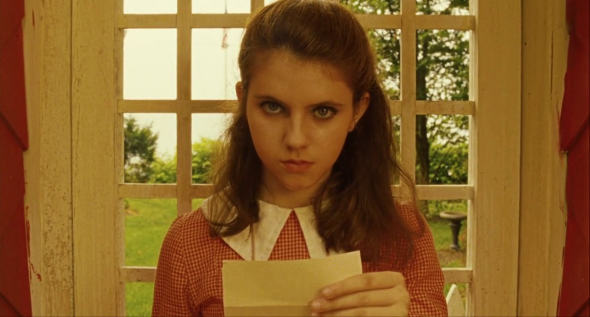
I always wished I was an orphan. Most of my favorite characters are.
Meet Suzy. Suzy is also precocious, but not in quite the same ways. Her family lives on the same island where Sam is camping. And the main thing about Suzy is her circumstances. Not that she’s just a placeholder, or anything — Suzy is a really vivid and well drawn character: driven, conflicted, passionate about stories and her place in those stories, given to melodramatic gestures, and really, really angry. But this anger is directed at her parents, two emotionally reserved lawyers who are conducting their marriage as a brutal war of psychological attrition, and in particular at her mother, who has recently begun to have an affair with the island’s only cop (played against type by Bruce Willis, who brings a touching sad-sackery to the part). You don’t get a sense that Suzy would be as bookish if she had grown up on an island where there were more kids to play with. You don’t get a sense that she’d be as angry if her parents weren’t emotionally stunted — or even if her mother was, like, five percent better at keeping secrets secret. So even though the family unit she comes from is pretty much the Default Wes Anderson Family Unit, her reaction to it is new. The anger, the destructive will to harm… this isn’t a side of the story that we’ve seen before, and it feels fresh, and real, and human. (It’s almost into Rosencrantz and Guildenstern are Dead territory: what would it be like, as an actual human being, to have to deal with Wes Anderson People day in and day out? How angry would you get?)
The plot, in a nutshell: Suzy and Sam meet during the island’s annual community production of the Benjamin Britten children’s opera Noye’s Fludde. (She is playing the raven, which if you know the opera’s plot is probably significant.) They become pen pals, and pen more-than-pals, and eventually plan to run away together. The next summer, they strike out into the wilderness, traveling to an isolated cove on the far side of the island where they set up camp, catch some fish, and — at least symbolically — have sex. It’s probably more than symbolic, but they’re tweens, so it’s elided. So, digression: the actors are actually pre-teens, and I’m amazed there wasn’t more brouhaha about this scene at the time, because while it’s not exactly prurient, it’s really intense. Rather than fading discreetly to black, Anderson just separates the sex out into its component parts. There’s exposed skin: they go swimming in their underwear. There’s bodily joy and connection: they dance together, both wildly and intimately (in their underwear.) And there’s a moment of painful penetration: he helps her pierce her ears with a fishhook. (In their underwear.) It probably helps that Sam and Suzy talk like hyper-articulate 40-year-olds. Still, I guess Wes Anderson gets the “it’s art so it’s fine” pass?
But here’s an important thing. Sam apparently thinks that he and Suzy are just going to stay there, living off the grid, for-actually-ever. It doesn’t occur to him that they might survive a harsh New England winter. It doesn’t occur to him that anyone would come looking, or at least not that anyone would find them. Suzy, on the other hand, has no such illusion. She doesn’t pack for a long stay. One of the things she brings is a battery-powered record player… and she leaves a note for her brother saying that she’ll return it in a couple of days. Suzy does think that they’ll get caught, and she’s right about this. So she’s not running away to be with Sam (although one of the things that makes her so compelling as a character is that, despite this, her affection for Sam appears to be sincere). Suzy’s running away because she thinks it will hurt her mother. She’s right about that, too.
Eventually, Suzy’s parents, and Sam’s scoutmaster (played essentially as a grownup version of the DWAP by Ed Norton), manage to track the young lovers down. Sam ends up shouldering the blame, and because his current foster parents have decided that he’s too much trouble to have around the place, he is scheduled to be sent to “juvenile refuge” as soon as Tilda Swinton can show up to collect him. In the meantime, Officer Bruce Willis takes him into custody, and the two form a tentative bond. At this point, Sam’s fellow khaki scouts (who spent the first half of the movie trying to track him down), have a change of heart. They bust Sam and Suzy out of custody/grounding and try to send them off in a canoe with enough supplies to make a go of it. And it seems like Suzy does mean to go for good, this time. But the escape goes south immediately. There are some explosions. The island gets slammed by a hurricane. Everyone ends up taking shelter in the church, where Sam and Suzy try to disguise themselves by donning the Noye’s Fludde animal masks. They’re spotted, and get chased up to the steeple, where, rather than let Sam be taken by Social Services, Suzy decides that they should jump to their deaths… but at the last minute, Bruce Willis offers to adopt Sam himself. And then everything is fine. The steeple gets struck by lightning, and they all end up dangling off the side of the church — but everything is fine.
The last scene in the film is brief, and in that nobody is in danger of falling off a roof, or struck by lighting or dragged off by Social Services, it seems like it ought to be a happy ending — and maybe not even that important of a scene. But everything depends on it, as I’ll explain below. Suzy and her younger brothers are lounging around in their house’s attic playroom. She is reading. Her brothers listen to A Young Person’s Guide to the Orchestra on the portable record player. This mirrors an almost identical scene from the very beginning of the movie which introduced us to Suzy and her family, but with two crucial differences. First, Suzy is wearing a yellow dress instead of the pink one that she’s worn in nearly every other scene of the film. Second, Sam is sitting across the room from them, painting something with his watercolors. Her parents call the children down to dinner. Sam says “See you tomorrow,” and then Joey Potters it out of the window. (Bruce Willis is waiting for him at the end of the path in his police car.) Suzy smiles after him, looks pensively at the canvas and then walks out of the frame. And then the camera pans down and we see what Sam was painting: the cove where Sam and Suzy made their campsite.
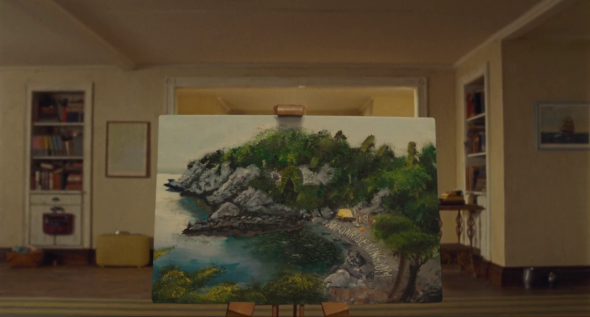
The main thing that Moonrise Kingdom is about is the end of childhood, which in this case means not innocence lost, but compromise accepted. However, it’s about lots of other things as well. And one of the things that struck me most about it, even the first time that I watched it, was the schematic way that Sam and Suzy’s gender roles are mapped out. When they ran off together for the first time, what did each of them bring? He brought a hatchet, a compass, a tent, matches, and all the other wilderness survival tools that he could carry, including, most notably, a map. She brought a collection of novels, the record player, her left-handed scissors, and most notably, a cat. He brings science, their daily bread, rigor, and systematization. She brings art, narrative, creativity, and — look, don’t blame me, Wes Anderson was CLEARLY going for this — pussy. Just to make sure we get the comparison, the first thing they do is run down a list of all of the things that each of them brought; just to make sure it’s systematic, the one “soft” thing that Sam DID bring, his watercolor set, is left out of the list in that scene. If we expand this out to include things that they bring to the table on a more abstract level, Sam is a member of a public organization (scouting), and Suzy, for all that she hates them, has a family. From a certain point of view, this complementarity is romantic. It’s not hard to think of Sam and Suzy as two halves of a single broken soul. But the faultline is placed oh so specifically along gender-normative lines! And that’s a little off-putting.
It’s hard to know quite what to make of this. Generally I look at stuff like this and say “These are harmful social scripts; people will internalize these and end up jamming themselves up psychologically in an attempt to be Manly/Womanly.” But because the gender roles are so self-consciously artificial (like everything else in the movie), I find it hard to imagine them sinking in in quite the same way as, say, the characterizations from Transformers. On the other hand, if there’s any kind of satirical point being made here about gender, or even any kind of commentary about it, it has sailed right over my head. If anything, perhaps the idea is that by using these very simplified and traditional gender roles, the film aligns itself with other genres that use similar characterizations: fairy tales and (via Noye’s Fludde again) morality plays.
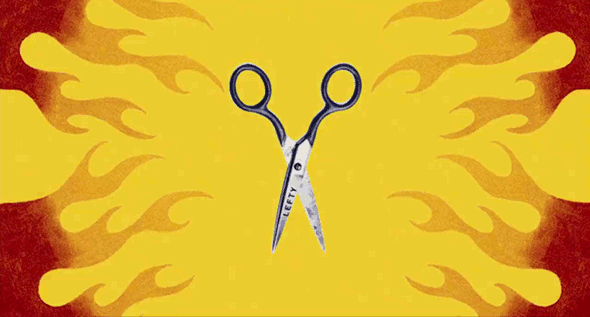
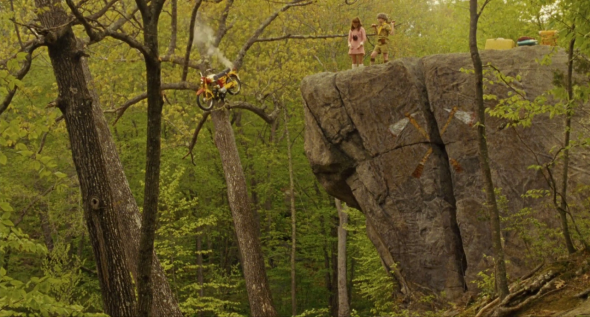
But here’s the thing that really interests me. Suzy is all blurry lines and jagged edges. Sam is right angles and flat surfaces. So why is it that the major threat, that drives climax of the film, is the idea that Sam, specifically, is going to be taken away and institutionalized? It’s not just that he’s vulnerable to it because he’s an orphan. They could just as easily have had Suzy’s parents decide to send her to reform school as they could have had Sam’s foster parents disown him. And why is the threat so abstract and symbolic? Various people refer to it as “the system,” an orphanage, a jail, a hospital… Tilda Swinton in her role as the bugaboo character refers to herself in the third person as “Social Services.” So it’s not the specific threat of a bad place he’s going to go to, but a whole interlocking system of social control and regimentation that he would be subjected to. And here’s the thing: for all that the other characters keep saying that Sam would get eaten alive in there… wouldn’t he fit right in? With his perfectly appointed campsite, and his agendas and checklists, and so on?
It’s at this point that I have to make a huge unjustified interpretive leap. What if… what if we think of this institutional cruelty not as something that might be applied to Sam, but as something he has the capacity to become? What if the threat of the film is not really a bad thing happening to this little boy, but that our regimented institutions — including scouting, which is of course as important a character as either of the two protagonists, but also everything else in the world that’s like scouting, including the law, the military, grammar, meteorology, and Sam himself — what if the threat is that these things may become something menacing and brutal, Sam included? What if that’s what Suzy’s meant to save him from, and what he’s running from, off in the wild?
And if that is the case, isn’t it odd that it isn’t Suzy who really saves him, in the end, but Bruce Willis’s policeman character? Ought we to feel the least bit concerned to discover that Sam’s happy ending entails dressing up in a little junior policeman outfit to look just like his new father? (Wes Anderson stalwarts will recognize this fashion choice from The Royal Tenenbaums. It doesn’t point to anything healthy.)
There are two ways of reading this. The depressing one is to think that the ending is not so happy as it seems. Sam has not been rescued at all. He’s in the system. He IS the system. And Suzy, denied her apocalyptic plunge into the churchyard, is now carrying on the junior version of an illicit affair with the junior version of the island’s police officer, meaning that she has become her mother — become, in fact the specific aspect of her mother that she hates the very most. In this light, the change of her dress from the pink that she wore at the start of the film to the yellow she wears in the coda, takes on a baleful significance: at twelve years of age she has already come from the bloom of the bud to the fade of the leaf; the cold hard winter of life now remains. (Remember that I said Sam could grow up to become Steve Zissou. Is Suzy going to grow up to become Eleanor Zissou? Cruel fate, troubling destiny.) Also troubling is that, whereas the crude figure watercolors Sam produced earlier in the film are genuinely striking, the final landscape of their cove and campsite struck me as almost Thomas Kinckaid-like in its wretched dentist-office conventionality.
That could just be my taste, though – I’m not SURE we’re supposed to think of the final painting as bad. But aren’t these better?
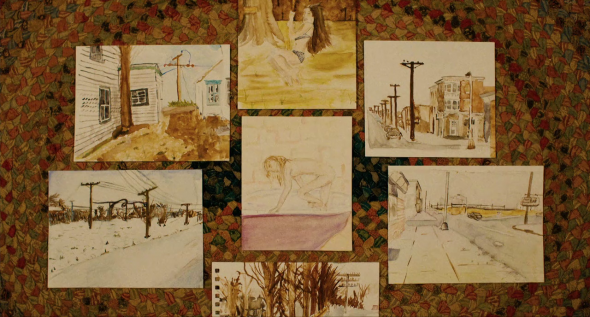
So much for the sad reading. The happy way to look at it is to say that there are some ways to be an institutionalizing force without losing your soul. You can be a DWAPy kind of person without becoming monstrous, but you must take special care: rather than entering into the broader social system, you’ve got to pull away from it, isolate yourself from it as much as possible, retreat to a secluded island with no roads, and there become the sole representative of the law, benevolent absolute monarch of a twee and fanciful kingdom. This is after all what Scoutmaster Ed Norton has effectively done, and he’s meant to be a good guy. (And then, unjustified interpretive leap number two: isn’t this also what Scoutmaster Wes Anderson has done? His precisely controlled films are clearly more the product of a Sam-like cartographic impulse than they are of Suzy’s storytelling faculty.) Suzy’s family’s house is called “Summer’s End”; the film is fundamentally about the way that childhood ends. Some don’t make it out at all, destroying themselves (and as much world as they can reach), in apocalyptic explosions of liquescent desire. And then A.E. Housman writes poetry about them. But the rest of us take the safer path: we arrange to have ourselves adopted by the most benevolent police that we can find. And then we hope for the best.
So is it a happy ending or not? I think it really hinges on that final scene: on that smile…
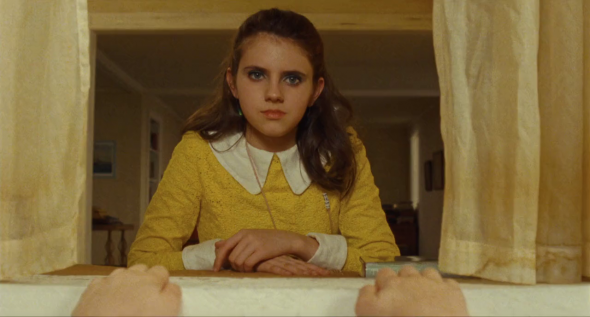
and on that pensive glance…
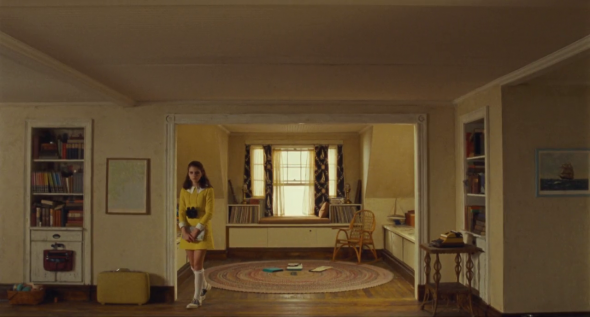
and how much fondness, and how much Weltschmerz, you see in the one of them and in the other. And I think that that’s up to the individual viewer to decide… but it’s not an obvious choice. Whichever way the scale tips, it doesn’t tip by much.
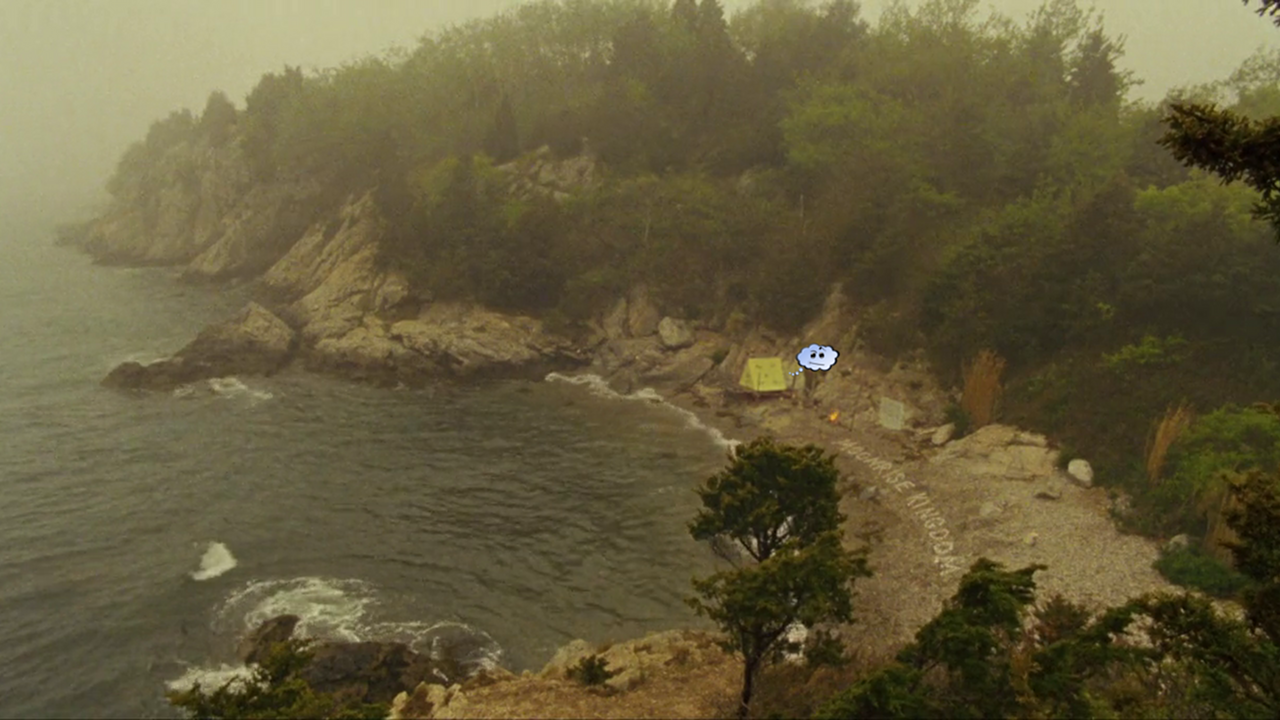
p.s. Thanks to the OTI crew for letting me bounce ideas off of them on this one.
p.p.s. Well actually, it’s spelled Thomas Kinkade. (Yeah, I could go back in and edit it, but I stand by my tyops and mispellings.)
Your thesis seems to be that the the only way for Sam to adjust is to seclude himself from society on a small island with few children (or at least, that is what Anderson is trying to say) or to embrace some other structure (Willis).
I think that’s plausible, but I’m not sold yet. Sam has found one person he is very strongly attached to (though he eventually forms some attachments with Norton and Willis), but I don’t think that’s supposed to be Sam secluding himself from the world, but reaching for his desire for freedom. He doesn’t want to be away from people, he just wants to do as he pleases.
Working counter hypothesis:
Sam is surely a creature of habit and structure for sure, but what if we view this as a survival mechanism rather than his primary character trait? He wants to branch out, but he is never in one home long enough to form relationships that allow him to do that.
Motivation:
His primary trait isn’t his analytic brain, but his desire to be free. He uses logic to justify his actions, but his motivations for taking these actions in the first place are not motivations of order, but a desire for freedom with his sad eyed girlfriend. The tragedy of moving from home to home isn’t just that nobody loves him, it’s that he is stuck in a system that he wants to break free from.
Mindset:
This is enforced by the way Sam wants to end his childhood (in his mind). He wants to assume more responsibility for himself, but only incidentally because he wants to be free of being told what to do. “He is the homo-sacer, and feels like he should be allowed to do as he pleases because he’s learned enough now to know how the world works.” This mindset proves to be wrong in how the world actually works, as you mentioned, but I think Sam would agree with that as a narrative of how the world should work.
The Ending:
Sam’s growing up lesson seems to be that things don’t turn out the way he wants them to, and that idealizing his way to an answer doesn’t make it so. But whether he is dressing up like Willis and is falling under a new structure, or running away from the orphanage on this small island to hide in the woods, this is just his survival mechanism to do what he ultimately wants. He just wants to sneak out of Suzy’s window. He doesn’t want to leave out the front door and ask permission from Murray and Mcdormand. Sure, everyone knows what’s going on and they all are allowing it to happen and Willis is literally there expecting him, but he is still able to act out his freedom narrative and let his dream live out a little longer.
I’d love to hear thoughts!
Wouldn’t you say that his setup at the end is, like, the socially approved channel of social rebellion? Rather than doing something actually radical, he’s become a member of the loyal opposition?
As to the idea that Sam’s primary trait is his desire for freedom — this is an interesting idea, but I guess I just don’t see it. Maybe the film just doesn’t spend enough time showing him chafing under the restrictions of the khaki scout lifestyle… or maybe it doesn’t spend enough time showing him enjoying freedom. (On his own, I mean. There’s a lot of time devoted to him and Suzy dancing on the beach, but if it was freedom that he was really after, you’d expect a scene of him, like, rolling on his back in the grass while she sleeps, or something.)
I don’t think there’s as much ambiguity. To me, it seems like a pretty clearly positive ending. Sam’s relationship with Suzy is no longer illicit, remember. He’s not there in secret. He’s painting in broad daylight with the other brothers.
So he’s emphatically NOT like the Captain Sharp, or the other rather hypocritical adults. And it’s not like the captain himself is totally a sad sack (not as much as Mr. Bishop, anyway). As he himself admits, he’s dumb, but he does what’s more important than being smart; he makes the right decision by choosing to adopt Sam and to cut off the affair with Suzy’s mother.
There was no reason to keep Sam and Suzy apart. The flood, God’s punishment, was sent to teach their little world a lesson about true love. And the lesson has taken; that’s why the adults allow Sam and Suzy to keep seeing each other.
I have a different interpretation of the paintings as well. The early ones are rather forlorn, gloomy. Empty spaces, bleak midwestern streets, telephone poles. Neither painting is really that good, technically, but the painting of the cove is lush, vibrant, colorful. And the painting itself is only an object which lets the film show us what it has been about all along: the real “Moonrise Kingdom,” their love.
I don’t think that Suzy is a completely new DWAP as proposed by the OP. I think that she displays exactly the same cool anger towards her dysfunctional family as Margot in Tenenbaums , and her strategy for dealing with this is also the same. She is intelligent, angry , secretive and aloof. Her ultimate coping strategy is to run away. This applies to both women. There’s also a direct correlation between these character traits and Rosemary Cross (Rushmore) .
These 3 female characters are as much DWAPs as any of the male characters listed in the article , I would suggest .